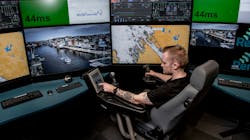The rise of remote operations in the offshore energy industry
Editor's note: This story first appeared in the May-June 2023 issue of Offshore magazine's Remote Inspections & Operations Special Report.
By Trond Notland, Remota AS
In the age of digital transformation, remote operations have become increasingly prevalent in the offshore energy industry. There has been a rise of remote technologies, such as unmanned surface vessels, drones, robotics, remotely operated vehicles (ROVs) and autonomous underwater vehicles (AUVs), that have had an impact on offshore operations. From reducing travel costs to improving safety and efficiency, remote technologies have revolutionized the industry, making it more sustainable, diverse and resilient. The world of remote operations has the potential to shape the future of the offshore energy industry.
The industry has always been associated with complex and hazardous operations that require a lot of labor, time and resources. But with the recent push toward sustainability and cost efficiency, the industry is turning to remote operations as part of the solution to these challenges. Remote operations refer to the use of unstaffed or lightly staffed vessels or platforms to conduct tasks offshore, from inspections and maintenance to drilling and production.
Benefits of remote ops
One of the main benefits of remote operations is reduced travel costs. Offshore operations require a lot of travel, and this can be a significant cost for companies. By using remote operations, companies can reduce the need for travel and save money on transportation, lodging and meals. The workforce can spend more time with their families and reduce the environmental impact frequent travel results in.
Safety is increased by moving personnel away from the potentially harsh environment offshore. The offshore energy industry is known for its harsh and dynamic working environment, and remote operations can reduce the risk of accidents and injuries. By using unstaffed or lightly staffed platforms, workers can avoid exposure to hazardous materials and dangerous environments. This can improve safety and reduces insurance costs and liability.
Modernizing inspections with remote operations can also improve the accuracy and speed of them. By using drones, advanced cameras and sensors, inspections can be conducted with greater precision and efficiency. This reduces the need for physical presence offshore, which can be costly and time-consuming. With remote inspections, issues can be identified and addressed quickly, reducing downtime and improving overall productivity.
Finally, remote operations can contribute to sustainability efforts. By reducing travel, companies can lower their overall carbon footprint and minimize their impact on the environment. Remote operations also allow for better resource utilization, as companies can optimize their operations and reduce waste. This contributes to a more sustainable and efficient industry overall.
Challenges
While there are many benefits with remote operations, there are several challenges that must be addressed. With remote operations, the activities are often located far from the central office and may have limited access to communication channels. This can make it difficult to coordinate tasks and ensure that everyone is on the same page. Companies must invest in robust communication systems to ensure that workers can communicate effectively and efficiently.
High latency can be a significant challenge for remote operations, particularly when using geo-stationary satellite systems for communication. Latency refers to the delay between when data are sent and received, and with satellite systems, the distance that the data must travel can result in significant delays. This is a physical limitation of how fast the signal travels.
While low-orbit satellite systems offer many advantages, such as global coverage and lower cost compared to traditional satellite systems, they can also suffer from high latency. This delay can be especially problematic in remote operations, where split-second decision-making is often required.
One solution to this challenge is to use 4G and 5G networks offshore. These networks can provide faster and more reliable communication than satellite systems, with lower latency and higher bandwidth. Additionally, they can offer more security and privacy than satellite systems, as the data are transmitted through a private network.
There are, however, challenges to implementing 4G/5G networks offshore. These networks require significant infrastructure, such as towers and antennas, and may be affected by the harsh offshore environment, such as storms or sea spray. Additionally, the initial investment and ongoing maintenance costs can be high, which may be a barrier for some companies.
Despite these challenges, the benefits of 4G/5G networks for remote operations are significant. They can improve communication and decision-making speed, increase safety and efficiency, and reduce costs compared to satellite systems. As the offshore energy industry continues to embrace digitalization and remote operations, these networks are likely to become an increasingly important part of the communication infrastructure.
Communication costs
The costs of both satellite and 4G/5G networks can be high, which can be a barrier to adoption for some companies. For these communication technologies to become more widespread in the offshore industry, it will be important to reduce their cost and increase their accessibility.
One potential solution to reduce the cost of satellite systems is to utilize shared networks, where multiple companies share the same satellite system and the associated costs. This can help to reduce the upfront investment required for individual companies and make satellite communication more accessible for smaller companies.
Similarly, the cost of 4G and 5G networks can be reduced through innovation and increased competition in the market. As more companies adopt these networks for remote operations, there may be economies of scale that result in reduced costs for everyone.
Overall, while the cost of these communication technologies is a challenge, it is important to continue exploring and investing in them, as they offer significant benefits for the offshore industry in terms of safety, efficiency and environmental sustainability.
Regulations
Regulations are a critical component of ensuring safety and security in the maritime industry. However, implementing regulations can be a challenge due to the global nature of the industry and the different regulatory authorities involved.
One of the challenges facing regulations in the maritime industry is the lack of a uniform set of international regulations. This can result in confusion and discrepancies between different countries and regions, making it difficult to operate internationally.
To address these challenges, the industry needs to work together to develop and implement effective regulations. This can be achieved through collaboration between regulatory authorities, industry stakeholders and technology providers.
Cybersecurity
Another challenge of remote operations is cybersecurity. With unstaffed or lightly staffed vessels and platforms, there is a risk of cyberattacks that can compromise sensitive information and operations. Companies must implement an effective cybersecurity program to protects against these risks, including encryption, firewalls and regular security audits as safety measures.
The implementation of remote technologies, such as drones, robotics and AUVs, in offshore operations has significantly reduced the risk of injury and improved overall safety. However, it has also introduced new risks to cybersecurity. Remote operations are often controlled by digital systems, which can be vulnerable to cyberattacks such as hacking, phishing and malware.
One major concern is the potential for hackers to gain unauthorized access to the remote system and cause damage or disruption. Cyberattacks could lead to the loss of critical data, operational downtime or even physical damage to equipment. These threats pose financial risks and could also jeopardize the safety of personnel and the environment.
Another risk is the possibility of insider threats, where employees or contractors with access to the remote system may intentionally or unintentionally cause harm. This could include tampering with data or equipment, stealing confidential information or sabotaging the system.
Furthermore, the use of personal devices and unsecured networks could increase the risk of cyberattacks. If remote workers use their personal devices to access the remote system, they could introduce vulnerabilities in the system's security. Preventing unsecured networks, such as public Wi-Fi, is also important to prevent cybercriminals access to the remote system.
To mitigate these risks, companies need to implement robust cybersecurity measures. This includes conducting regular cybersecurity assessments, monitoring system logs for suspicious activities and implementing access controls to limit who can access the remote system. Companies should also ensure that all remote workers are trained on cybersecurity best practices, such as using strong passwords and avoiding public Wi-Fi. A layered approach where everyone is trained and equipped to prevent and recognize cyber incidents is key.
In summary, while remote technologies have brought numerous benefits to offshore operations, they have also introduced new cybersecurity risks. Companies must prioritize cybersecurity to ensure the safety of personnel and equipment, protect confidential information and prevent operational downtime. This is a subject that also garner more focus in traditional maritime operations.
Workforce
Remote operations may face resistance from workers and unions that are concerned about job security. By reducing the need for physical presence offshore, remote operations may lead to job losses or reduced work hours for some workers. Companies must work with workers and unions to ensure that they understand the benefits of remote operations and are prepared for any changes that may occur.
Solutions
To address these challenges, companies must invest in the right technology, training and communication systems. One of the most important technologies for remote operations is drones. Drones can be used for inspections, maintenance and even transport, reducing the need for physical presence offshore. Companies must invest in drones and train workers to operate and maintain them effectively.
Artificial intelligence
Artificial intelligence (AI) can be playing an increasingly key role in remote operations and inspections in the offshore energy industry. AI-powered systems can analyze large amounts of data quickly and accurately, making it easier for remote workers to make informed decisions.
One example of how AI is being used is in the analysis of inspection data. Traditional inspection methods involve sending workers to physically inspect equipment, which can be time-consuming and costly. With AI-powered systems, inspections can be done remotely using drones or cameras, and the data can be analyzed in real time to identify potential issues or defects.
AI can also be used to predict and prevent equipment failures. By analyzing data from sensors and other sources, AI algorithms can identify patterns and anomalies that may indicate an impending failure. This allows maintenance crews to take proactive measures to prevent the failure before it occurs, minimizing downtime and reducing costs.
Furthermore, AI can be used to optimize operational performance. By analyzing data from sensors and other sources, AI algorithms can identify areas where operational efficiency can be improved, such as optimizing energy usage or reducing waste.
Overall, the use of AI in remote operations and inspections has the potential to revolutionize the offshore energy industry, making it more efficient, cost-effective and safe. However, companies must prioritize the security and fairness of AI-powered systems to ensure that they are used ethically and responsibly.

